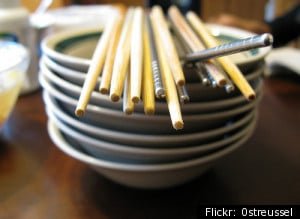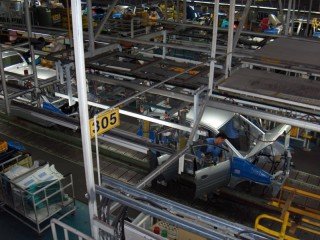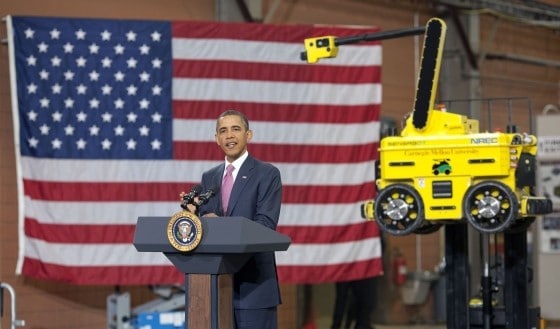Luckily for US citizens, not everything is getting outsourced. There are some US companies, such as Georgia Chopsticks LLC, who have seen opportunities in durable goods manufacturing and now provide reputable exportable US made product to offshore countries. These entrepreneurs should be commended and encouraged by local populations and governments in the absence of any recognizable federal support; their ratio of job creation is very high compared to the actual jobs created in their factories, or those created by government bail outs.

by Jack J C
I once worked in a fairly remote community that had two major employers, a durable goods manufacturer and the regional general hospital. The local spin off job creations of both major employers were estimated to be 1:6 which means that for every job related to creation of durable product or necessary service, an additional 6 jobs were created in local support jobs such as grocery, domestic parts sales, and so on. Assuming a married couple with 2.19 children and only one worker in the family the theoretical ratio of supportable population becomes 1:29.33 meaning that for each worker employed in a necessary service or manufacturing role, 29.33 people are supported. With two employers at 3,000 people combined, the total supportable population of the area was 87,990 people – from 3,000 necessary service or manufacturing jobs. Of course, not every family will have one bread earner but I think the point is well made, durable goods manufacturing leads to a very large increase in overall support and service jobs thus creating a strong local economy.
In addition to the local jobs created at a 1:6 ratio, there is a national ratio that is higher yet for durable goods manufacturing. These additional jobs are attributed to transport, warehousing, dealerships, and repair. I vaguely recall that the 1:6 ratio leveraged into 1:15 nationally (original 1:6 included). Of course local necessary service jobs like hospitals do not spin off as many national jobs so the national ratio for necessary service organizations is considerably lower.

In November of 2011 Hyundai/KIA – you know them, the Korean automotive makers, now fourth largest in the world that started out in 1955 by throwing recycled oil drum bodies onto Jeep running gear – published a ‘jobs benefit’ article on the effects of Hyundai/KIA on the US economy.
Hyundai/KIA directly employs 5,199 people in the USA. These jobs provide spin off jobs totaling 28,114 for a ratio of 1:5.4 which is pretty close to my original ratio. This can support a theoretical population of 977,000 people assuming one bread earner and 2.19 children per family. Hyundai, operates technical centers in Michigan and California and has a 2,000 personnel factory in Alabama assembling cars. However, Hyundai/KIA do not fabricate many parts in the USA, the plant is mostly an assembly plant.
The total jobs spin off for Hyundai/KIA investment in the USA is a staggering 94,391 private sector jobs or a ratio of 1:17 leveraged nationally and an economic value of 5.9 Billion USD annually in wages and salaries providing taxes on the order of 1.77 Billion USD at a 30% tax rate. Providing a very good example of how durable goods manufacturing sustains an economy.
In comparison to durable manufacturing, the ‘trickle down’ policies of the Reagan era (and now Bush and Obama) were designed to reduce taxes on the wealthy thus ‘encouraging’ the wealthy to spend more on non-durable products and service based industries, or investing in the USA. Unfortunately for economists pushing this concept, some simple facts regarding the totality of society were never properly analyzed. For wealthy people to invest in an area, they look at the rates of return on the investment which must exceed common rates of return available at banking institutions. It is seldom that durable goods manufacturing provides rates of return above 4-8% once all the financial work is done, in fact that 4-8% range is shareholder portion of a 30% Gross Margin and tends to the 4% side of the scale. For large investment portfolios, Banks commonly exceed 4-8% therefore there is no encouragement for the wealthy to invest in durable goods manufacturing. Additionally, durable goods manufacturing requires constant care and attention, so the investment in time is high – again not something that would induce an already wealthy person to invest in this sector. Retail has higher gross margins than durable goods, and software development is higher yet but these industries are essentially service industries, requiring durable goods as a base. In terms of strict investment potential, these industries are, however, more attractive.
By using tax dollars to bail out the bankers in 2008, Obama again played into the hands of ‘economists’ who failed to look at the totality of society. Banks are one of the most parasitic, yet necessary organizations on the planet (assuming we continue the current monetary value system) but their value to the general population in terms of job creation is very low compared to durable manufacturing. Jobs provided by the banking sector at the local level are included in that 1:6 ratio – the old “Well I’d like to take that loan out for the new boat at x% compounding daily but I only work at McDonalds making $5.99 per hour” compared to “Well I earn $15.99 per hour over a standard 40 at XYZ Mfg and have $x,xxx savings I’d like to put down on that new boat! What’s your interest rate and terms?” Thus any jobs created by the banking sector are again dependent on durable goods manufacturing.

In order to return the US economy to a position that is sustainable, the US government should reduce the footprint that the US military has in the world, and use that saved value to rebuild the US infrastructure into a modern one comprising good highways, interlinked high speed rail, and reduced carbon footprint. The jobs created by these infrastructure updates could restart manufacturing in the USA thus producing and even improving on that staggering 1:17 durable/support job ratio we see from Hyundai. As there are many jobs currently tied up in the Industro-Military complex, the shift would have to be gradual, so this would require closing a base or two and releasing an upgrade contract for New York this year, Chicago next, and so on. This slow planned process gives large suppliers of military goods times to adapt their lines and product and fosters internal manufacturing. As companies adapt their lines, the process speeds up, and by concentrating on manufacturing areas where the US is now weak, some substantial scientific advances may occur. By ensuring that an up to date and well equipped military force is retained the USA would still be safe from invasion, and by reducing the bloody footprint and reputation the US has gained over the last 50 years the US would also be safe from ‘terrorism’. Sadly, I doubt that the US political system has the will or ability to carry out this idea or even sufficiently independent Economists to analyze it’s potential. Economists … reminds me of an old joke, so in closing:
An engineer, architect, and an economist were stranded on a barren island with only a can of beans for food but no can opener. The engineer said he could open the can by using his glasses as a lens to start a fire and the heat from the fire would raise the steam pressure inside the can, causing it to burst and thus open the can. The architect said that was a good idea but they needed an enclosure to keep the beans from flying all over the island from the explosion. In their dilemma the two turned to the economist to ask his opinion.
The economist replied, “Oh that’s easy! Assume a can opener!”
Groans not accepted! Cheers and a Happy New Year!
Editing: Debbie Menon
Jack JC, is a reserve Officer in a NATO aligned country, he has a Bachelors Degree in Mechanical Engineering and an interest in the strategic effects history and culture bring to present geo-political affairs. As an international traveler he has friends and family serving in both NATO and non-NATO countries and would prefer that his friends and family in both camps not kill each other. He has operated at senior corporate levels of management, and has developed equipment for both civilian and military use.
ATTENTION READERS
We See The World From All Sides and Want YOU To Be Fully InformedIn fact, intentional disinformation is a disgraceful scourge in media today. So to assuage any possible errant incorrect information posted herein, we strongly encourage you to seek corroboration from other non-VT sources before forming an educated opinion.
About VT - Policies & Disclosures - Comment Policy



